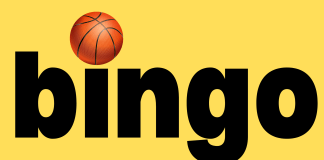Have you seen all those pictures being posted on Instagram, Pinterest, and Facebook, of something that looks like a colorful, artistic, hand-drawn planner? Notebook pages with fancy calligraphy, flourishes filling every inch of white space, and a color-coded system that takes a rocket scientist to de-code?
Chances are it’s a bullet journal…on steroids.
I love post-it notes, pens, sharpies, and mechanical pencils, and I have a weakness for books, planners, note books, and journals . . . but I HATE journaling. Absolutely HATE it. It’s just not my thing. But planning? That’s my jam! I could spend every minute of my day planning…anything! I always have a million lists going, because there’s no greater satisfaction than crossing something off a list. Except for maybe actually making the list to begin with. In fact, I should probably start including list-making on my short list of hobbies. (See what I did there?)
You see, I am the farthest thing from artistic and creative, so when I started seeing super fancy, elaborate, and out-of-this-world hand-drawn planner pages, I thought, “Absolutely not. There’s no way, NO WAY, I would ever be interested in doing something like that. That is not up my alley!” I didn’t understand why on earth anyone would ever want to draw their own pages when stores are filled with planners ready to go?!
But, after reading this blog, I had an epiphany. A bullet journal was exactly what I needed and is indeed right up my alley!
So here you have it: the basics of the bullet journal!
What is a Bullet Journal?
Very simply put, a bullet journal is a hybrid planner/journal/task tracker/to-do list that the creator describes as “a customizable and forgiving organization system.” Instead of having a planner, a journal, a sketch book, a million papers with different lists, etc., you can now keep everything together in one place. And yes, most people draw out, or divide their pages by hand, but don’t let that scare you. A simple, monochrome journal works just as well as a full-color masterpiece!
Supplies
Notebook/Journal
There is a notebook created specifically for bullet journals called the Bullet Journal Notebook. But any notebook or journal you have laying around will do. If you need to buy something new to get started, consider something with dotted pages or graph paper. I happened to have a spiral bound graphing notebook collecting dust, so I went with it and really like it! Just keep in mind the size. If you plan to take it everywhere with you, smaller might be more practical.
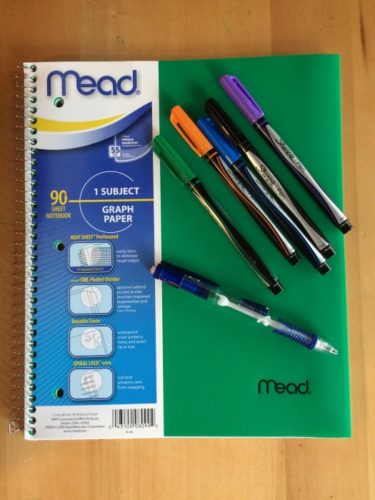
Writing Utensils
If you’re like me you might lean towards a pencil at first, but once you get the hang of it, colored pens are a fun and easy way to add a pop of color without going crazy! So far I’ve been liking the Sharpie pens, they don’t bleed through the paper and allow me to write small when I need to.
That’s it–just a notebook and pen and you’re ready to get started!
Parts of a Bullet Journal
When first getting started, keep it simple until you figure out what works best for you. But the backbone of the bullet journal includes:
Index
I about hightailed it out of the internet when I read I’d need an index. I mean, how complex was this going to be? Yes, your bullet journal will need an index. The point of a bullet journal is to set it up with some initial pages, and then enter things in as they come up. Did you decide you want to take the family on vacation and need a place to track your vacation planning and packing lists? Just go to the next blank page, start your list and enter it into the index so you can quickly find it later after you’ve added more pages to your journal. Now is probably a good time to mention that you’ll want to number each page.
The index itself isn’t super fancy; it’s basically just a list of sections and topics and the pages on which they can be found.
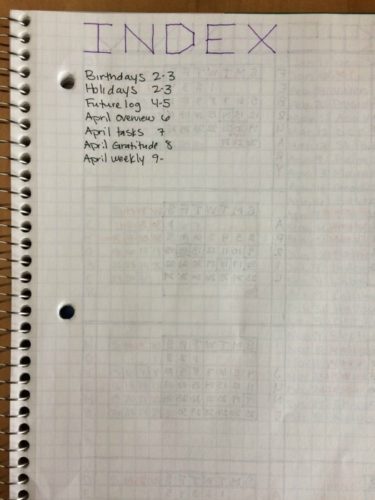
Future Log
Don’t let the fancy terminology distract you; a future log is really just a year-at-a-glance section and a place to track bigger events and happenings as they are scheduled throughout the year.
Your future log can be set up in a number of different ways. I went with a box for each month, in which I can list events and things I want to see at a glance throughout the year.
Number the page(s) and enter the future log into the index.
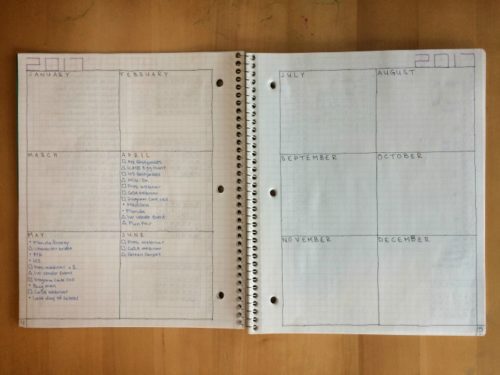
Monthly Log
Typically, the monthly log is set up on a single page with the days of the month running down the left side of the page. You can also include the day of the week before or after the date. Here you can list things you want to remember for each day (kids’ doctor appointments, first day of school, important work meeting, etc.). On the right side of the page is where you can keep a list of tasks you want to complete during the month, but that don’t necessarily have a set day/time to be done.
Number the page and enter it into the index.
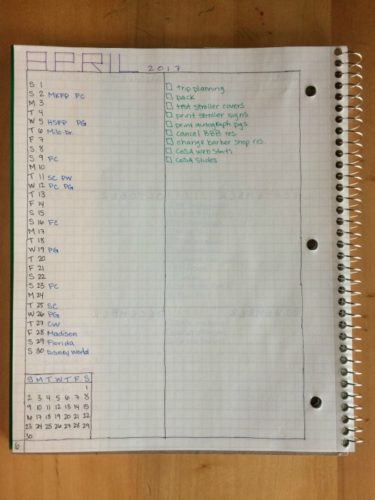
Weekly/Daily Log
I really like my planners to have weekly planner pages, so that’s what I created in my bullet journal. The weekly log shows a week at a time and provides slightly more detail than the monthly log. With the weekly log, you can either sit down and create all your weekly log pages at one time or create them as a new week is starting. I preferred to create all of my weekly logs for April at one time so they are together in my journal, as opposed to being broken up by other pages that get created during the week. Either way is fine!
The daily log lets you work with one day at a time. Daily logs can be useful if you are really busy and have a lot going on each and every day, or if you like keeping track of things that happen during the day. Remember, this isn’t just a planner; it’s also a journal! If little Sally says the cutest thing on Tuesday, and you want to remember it forever, enter it in your daily log for Tuesday. You can also keep track of things like that on the weekly log if you have room for them.
Number the page(s) and enter them into the index.
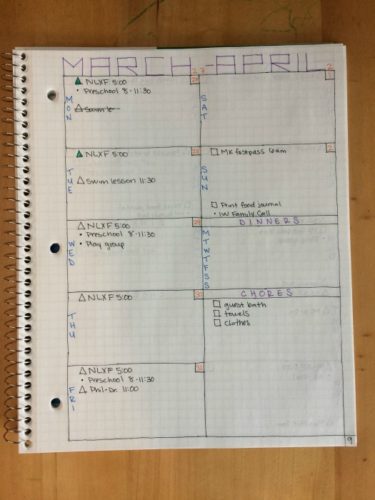
Collections
With collections, we enter the realm of lists and notes–this is where I started getting a little giddy! Collections are topical pages that you’ll create as you need them and can be things like: books you want to read, vacation planning, tracking your child’s first year medical stats, etc. Anytime you want to start a new collection, go to the next empty page and start one, number the page, and enter the collection name in the index along with the page number.
Whew! Are you still with me?
Okay, so you’re set up with the framework for an index, a future log, monthly log, weekly and/or daily log, and a collection or two. Now what? You’ve got the big picture, and now you need a system for the details.
Details
Signifiers
This is where SIGNIFIERS come into play. It’s called a bullet journal because that is how you will separate out each appointment, event, meeting, task, idea, memory, etc. But it’s more than just a bullet point! Since brevity is key in a bullet journal, we need a simple, visible way to distinguish between different types of entries. After reading a few blog posts on the subject, I decided to adopt the following signifiers that I found on The Lazy Genius Collective blog:
1. A box is for tasks and things I need to do. When the task is done, I fill in the box.
2. A triangle is for appointments and places to go. When it’s done, I fill in the triangle.
3. A dot is for things to remember or log. It could be anything from the name of that ultrasound tech who made me laugh to the book I just finished.
If you check out her blog, you’ll see she uses two, and sometimes three, other signifiers. At this point, I’m focusing on these three and may add in others as I get a feel for my journal. You can use as many different signifiers as you want, but for me, fewer is better or I can’t remember them all!
Migration
At the end of each month you’ll want to look back at the month to see what was completed and what wasn’t. For the incomplete tasks you’ll have to decide what to keep, what to discard, and what in your system needs revamping. This is called MIGRATION. When you migrate a task to the next month, indicate that with an arrow through the signifier so you know that task has been moved. If you don’t feel like rewriting the task, or you’ve already migrated it several times, then reevaluate whether you need to keep that task or not. If it’s not worth keeping, cross it out.
Embellishments
The last thing I want to go over is EMBELLISHMENTS. From the few pictures I’ve shared of my own journal, you’ll see that I have zero embellishments. Because I’m neither creative nor artistic, the thought of adding fancy embellishments gives me hives. But the nice thing about the bullet journal is that you can make it as fancy as you want! If you’re artistic and like drawing or sketching, use your bullet journal as a sketch pad and add as many embellishments as you want. You can also use washi tape, stamps, stickers, etc. to liven up your journal if the mood suites you.
Endless Possibilities
There is a world of possibilities in the creation and organization of your bullet journal. There are numerous other pages you can add, a few of which might include:
A Birthdays and Holidays Calendar
I placed this immediately after my index because I know I’ll be coming back to it often throughout the year and want to be able to find it easily.
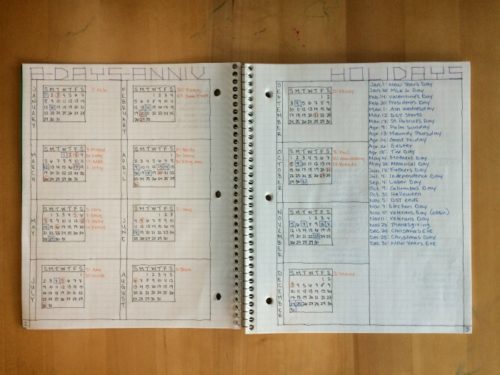
Monthly habit/task tracker
Are there things that you try to accomplish daily or several times a week? (E.g. exercise, meditation or prayer, chores, gratitude, self-care, quality time with your spouse, etc.) This can be a fun and easy way to track those things.
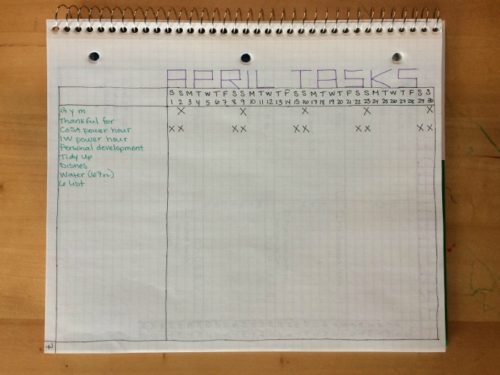
Monthly gratitude log
I really like the idea of a monthly gratitude log, because I’ve been trying to get in the habit of starting my day by thinking of things that I’m grateful/thankful for.
If you want more ideas, Pinterest has lots of good resources. Or check out #bulletjournal to see all the new and amazing things people are doing with their journals. But if that is overwhelming to you, start small and simple. As you get used to your journal and get a feel for what works for you and what doesn’t, you can revamp as you go. If you didn’t like the layout you chose for your weekly log, change it up the next week!
I hope this gives you a better understanding of what a bullet journal is, how to set one up, and how much fun they can actually be! I can’t wait to start using mine!
We want to hear from you! Let us know in the comments below if you are currently using a bullet journal or tried one in the past!
If you want to dig deeper, or are just curious where I started, check out these resources:
Bullet Journal – The Analog System for the Digital Age (by the creator of the bullet journal)
WTF is a Bullet Journal and Why Should You Start One? An Explainer
How to Bullet Journal: The Absolute Ultimate Guide






